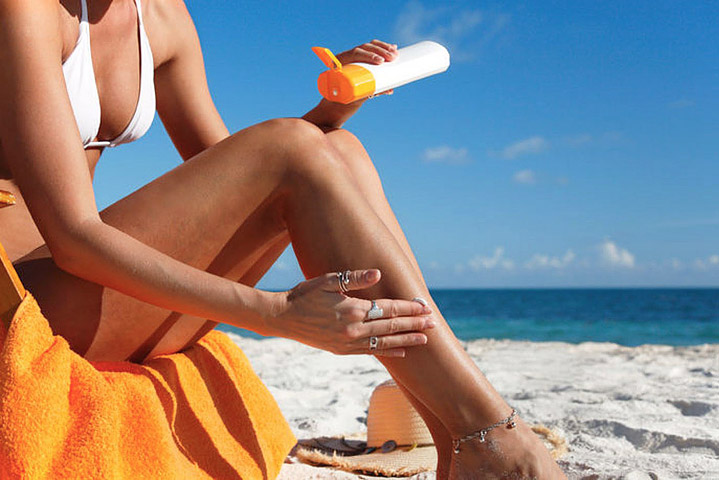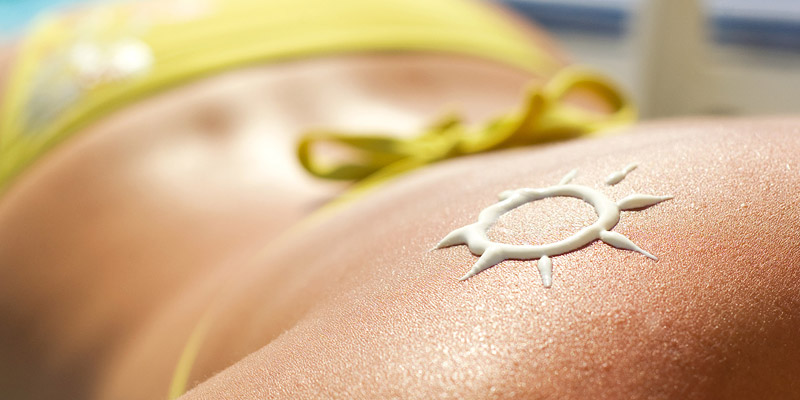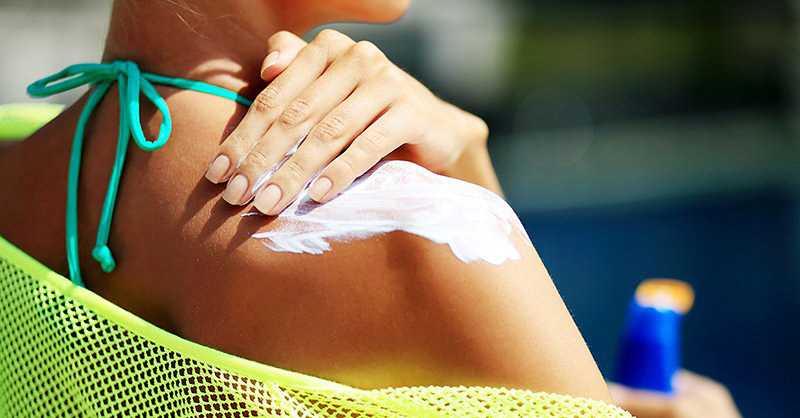
We all know sunscreen helps protect against the sun’s damaging rays. But despite this, not everyone wears it regularly—and what’s more, even among those who do wear sunscreen, most aren’t using it correctly. Read these 7 common—but easily fixable— Sunscreen Mistakes so you can protect your skin from cancer and the wrinkles, age spots, and rough skin that are signs of premature aging.
1. You’re not wearing a sunscreen every day.
It’s the incidental sun exposure during our lifetime (5 minutes here and 5 minutes there) that can contribute to an increased risk of skin cancer—as well as to increased wrinkles and premature skin aging. Most people don’t think they need sunscreen if they’re just outside for 5 minutes or on cloudy days (80 percent of the sun’s rays penetrate through clouds—even in winter). The sun’s ultraviolet (UV) rays can even penetrate through windows—in the office, home, and car—so you may be getting exposed even if you’re not outdoors. What’s more: sand, concrete, and water (as well as ice and snow in winter) can reflect up to 85 percent of UV rays—meaning even if you’re wearing a hat or are sitting under an umbrella, you’re still exposed.
That’s why you should be applying SPF—be it in your moisturizer or as a separate sunscreen— first thing in the morning so you start off with protection. Also, keep in mind that your lips and hands need protection, too: look for balms/creams with an SPF 15 or higher.
Regular sunscreen use does make a difference: a study in the Annals of Internal Medicine found that people who use sunscreen daily have “noticeably more resilient and smoother skin” than those who don’t.
2. You’re not applying sunscreen soon enough.
If you’re wearing a chemical sunscreen (anything with sun-protective chemicals like oxybenzone, octisalate, or avobenzone), you need to apply it at least 30 minutes before going in the sun. “This gives the sunscreen time to get into the skin and render the protection necessary,” explains dermatologist Jerry D. Brewer, M.D., a skin cancer specialist at the Mayo Clinic, in Rochester, MN.
If you’re wearing a physical sunblock—with non-chemical ingredients like titanium dioxide or zinc oxide—you can apply it when you’re out in the sun as these offer immediate protection.

3. You’re not layering antioxidants under your sunscreen.
Many sunscreens contain antioxidants, but they can quickly lose their potency. The reason: most antioxidants—like vitamins C and E, green tea, and pomegranate—aren’t stable enough to maintain their long-term benefits when mixed into a sunscreen. But antioxidants are critical because they help negate the skin-damaging and skin-aging free radicals generated by the sun’s ultraviolet light.
Antioxidant best bets:
- Elizabeth Arden Rx Triple Protection Factor SPF50+ with antioxidants and sunscreen,
- Dr. Brandt Lineless Infinite Moisture with the antioxidant vitamin E
- REPLERE Protect & Rejuvenate Day Lotion with antioxidants coffee berry, green tea, pomegranate, and more and,
- SkinCeuticals Phloretin CF Antioxidant Treatment Gel with antioxidants vitamin C and phloretin, a compound from apples.
4. You’re not applying enough sunscreen.
“The average person uses less than half the amount they should be using,” says Steven Q. Wang, M.D., director of Dermatologic Surgery and Dermatology for the Memorial Sloan Kettering Cancer Center, in Basking Ridge, New Jersey. “You need to apply a shot glass worth of sunscreen to your entire body every two hours.” So a typical 5oz bottle of sunscreen is really only 5 full-body applications. If you notice that you’re bottle of sunscreen is lasting longer than a few days when you’re on a beach vacation, you’re definitely not using enough.
5. You don’t reapply often enough.
You’ve rubbed in your sunscreen in the morning, but you can’t stop there. You need to continually reapply (at least every two hours) to get effective protection. Also know that spray sunscreens don’t cover skin as effectively as a lotion, so if you use them, you need to rub them into your skin and reapply sometimes more often than every two hours. “If you’re tanning through sunscreen,” says Dr. Brewer, “then either the sunscreen is not being reapplied often enough or too little is being put on.” Also, don’t be fooled by terms like water-resistant or water-proof. This means that the sunscreen may stay on your skin when you’re swimming, but once you get out, it’ll quickly get rubbed off when you towel off to dry.

6. You use SPF 50+ to get the most effective sun protection.
While SPF 50 may sound like a lot more protection than SPF 30, the higher the number doesn’t always guarantee much more protection and actually gives you a false sense of security.
In fact, studies show that sunscreen with SPF 30 can block about 97% of all incoming UVB rays (note that SPF designates protection against burning UVB rays—not UVArays) while SPF 50 only blocks 98% of all incoming UVB rays.
For most effective protection, you need to block against UVB and UVA rays, so look for a sunscreen that says “broad-spectrum” protection. New FDA rules state that if a product offers “broad-spectrum” protection, it must be stated on the front label.
7. You don’t avoid the sun.
“Everyone is always talking about using a sunscreen or wearing sun-protective clothing,” says Dr. Wang, “but very few people talk about avoiding the sun altogether. Instead of seeking shade or staying out of the sun between its strongest hours of 10 a.m. and 4 p.m., people go out and get as much exposure as they can.” And this is the problem.
“UV radiation causes direct DNA damage to the cells,” explains Dr. Wang. “Cells do have a mechanism to repair the damage, but as we get older, our repair mechanism diminishes. If the skin cells aren’t able to be repaired, cancer can result.” UV radiation also suppresses production of a key structural protein called collagen and accelerates collagen breakdown, causing wrinkling and eventually, sagging skin. “We’re operating on younger and younger patients with skin cancer,” explains Dr. Brewer, “so it can happen to you.” Follow these rules of sun protection and chances are, it won’t.




Leave a Reply